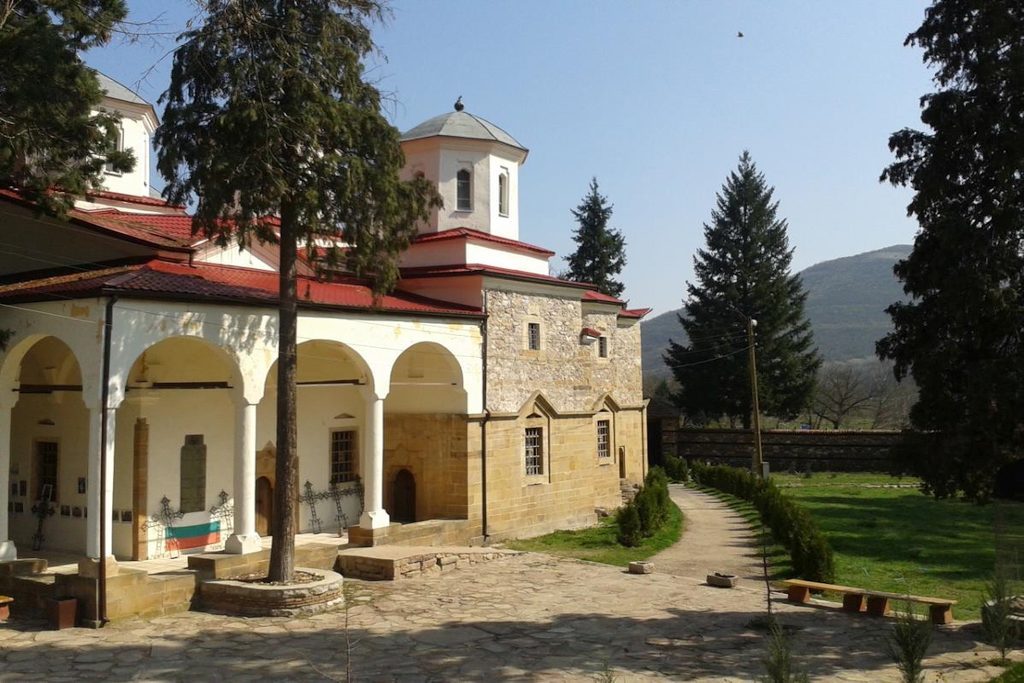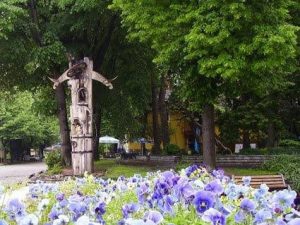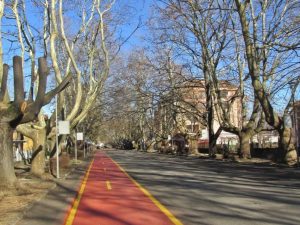

Lopushanski Monastery “St. John the Baptizer” is located in the Chiprovtsi area of the Balkan mountain in the valley of the river Augusta Dalgodelska valley, in the villages Pomezhdin, Melyane and George Damyanovo (until 1958 V. Lopushna). The monastery at 21 km away from Montana, at 30 km away from Berkovitsa and at 55 km west of Vratsa. It can be reached quite easily by car on the way from Montana to Chiprovci town. Follow the road to the village George Damyanovo. Shortly after passing the village, the monastery is near the road. IIn the place current of the monastery has never been another one, built in Second Bulgarian Kingdom. The fate of many Bulgarian monasteries was common in the era of Ottoman rule; they were repeatedly destroyed and devastated. After its destruction during the Chiprovtsi Uprising in 1688, it remained desertedfor a long time, and the population began to call it “the desert monastery”.
A legend says that the monastery mill on the river Augusta, often hosted the rebellious. One day, a father and his daughter left the nearest village to the monastery. Along the road he was followed by a Turk and he found refuge within the monastery, where it was present, also the commander Ognyan. The Turk came at the mill and throw himself upon the girl. In that moment, Ognyan jumped from his seat, from where he was hiding and killed him with an ax. The body was buried in the garbage from the stables, behind the building, but unfortunately the greyhound of the Turk became a silent witness to the entire incident. It returned to Berkovitz and started barking in his master’s house. Realizing that something was wrong with him, his relatives went after the dog, who led them to the mill. They began to dig into the pile of manure and found the body. The Turks burned the monastery and the monks were massacred. Only one of them escaped by fleeing to Serbia.
Between 1850-1853 at the initiative of priest Petko Iliev and with the cooperation of Archimandrite Dionysios, who came from the monastery of Chiprovtzi, along with his brother Gideon, began the restoration of the monastery. They were helped by the residents of nearby villages. In 1853 master Lilo together with graduate Slavin Tsaribrod build today’s impressicve church of the monastery the using very similar architectural style of Rila Monastery church. Along with the resumption of activity in 1853, Lopushanski monastery became a significant spiritual hearth. At that time, the monastery’s abbot, the monk Dionysius found a school for free education for children of poor parents from the surrounding area. The school develops educational activities. Meanwhile, the activities of the monastery engage in the Bulgarian people’s centuries-old battles for liberation, against the powerful oppressors, with the help of the monk Dionysius, hosting there the commanders Khitov Philip Totyo, Ivan Kunin and others. The monastery became a favorite place of national poet Ivan Vazov and during his stay there, he created some of the world famous novel “Under the Yoke”. During the period 1879-1881, the writer was appointed district judge in Berkovitsa.
In 1989 the Lopushanski monastery was rebuilt because the north wing was threatened by collapse. The main merit is of the abbot of then, Archimandrite Ambrose, who lived in a new building that had two beautifully carved porches.The Manastiski complex consists of a church, residential and farm buildings and white stone fountain surrounded by a stone wall.
The catholic temple is spacious, the church has three naves, is composed of the large nave, with the altar apse, two decorative apses on the east side, two side domes and two side chapels on the north and south side of the temple. Outstanding are the monumental arches of the circular gallery, built on twelve cylindrical columns. For the two lateral chapels, the arches encircle the entire north and south zone, and the whole western wall of the temple moves on the entire facade of the building. Throughout the large roof of the church are five richly illuminated domes that give the church an extremely picturesque image.
For unknown reasons the church of the monastery Lopushanski remained without paintings. There are some old icons that are valuable works of art, icons painted in Bulgarian. Two great icons of the iconostasis, Christ and the Virgin Mary were painted in 1863 by the eminent Bulgarian Renaissance painter Stanislaw Dospevski (1823-1878). A remarkable work of sculpture is a carved central iconostasis of the church from Samokov made by master Stoycho Stefanov Fandakova. When he carved this iconostasis with numerous floral motifs, birds, animals and Biblical scenes, he has proven his special ability and his exquisite artistic taste. Outside the walls of the church, the front door of the monastery is also decorated with reliefs of small stone, depicting people and animals. It is assumed that some images of the shown human figures reflect the temple builders. The residential wing of the Lopushanski monastery was done in the spirit of contemporary monastic architecture. It is superimposed with a feeble resistance. On the first floor there is a food facility and several guest rooms, while the second is the house of the abbot and there are several guest rooms.
Currently, the monastery is in an intensive work repair, is beeing built a new residential wing in place of the old one, which several years ago collapsed on the north side.
In the courtyard of the monastery can be seen, a white stone fountain with three drains, whose holy water comes from the springs located at 3 km away. In the corner of the courtyard is a small church “Birth of the Virgin” modest, for worship, used more in winter. That is why it is called – “the winter church” but is also known as the Chapel of the ossuary, because here are kept hundreds of bones, probably of the locals who participated in the Chiprovtsi uprising. Are used five bells, hung in the yard, taken into account by the monks for their history, two of them were brought from the temples from other villages below the dam – Jivovtsi and Kalimanitsa. Outside the temple stands a giant sequoia-giganteya planted in honor of the birth of former crown prince Simeon Sakskoburggotski. In the vicinity of the Lopushanski monastery there are still the remnants of eight late ancient fortresses. Most are in the region of Garden – Lopushanskis, Elovishkoto, black, Gornotserovskoto, etc. Historical sources say that the Roman emperor Augustus ordered to be built a gold mine in the sands of the magnificent scenery.
The altitude near the Lopushanski monastery is of 260 meters. And the climate around is known to be extremely beneficial in the treatment of lung diseases, and musculoskeletal. It is compared with that of Bankya and as proof, locals emphasize that for many years no accident had happeed since in the monastery exists the pioneer camp. The rivers are full of fish, the water is clear, the air – clean.Currently, the Lopushanski monastery is an activ place and its abbot is the young and ambitious Archimandrite John. The hermitage has 16 rooms and a restaurant – a kitchen, the payment is voluntary, has no charge, only depending on the generosity of each person. The most important thing is that of getting purified, to pray in silence, to light a candle, to socialize with God.




